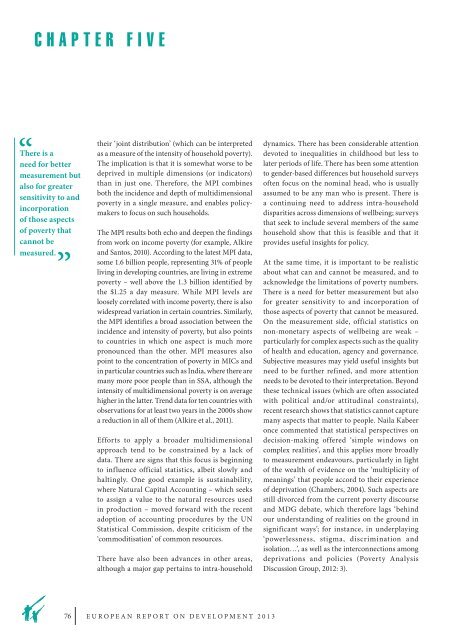Post 2015: Global Action for an Inclusive and Sustainable Future
Post 2015: Global Action for an Inclusive and Sustainable Future
Post 2015: Global Action for an Inclusive and Sustainable Future
Create successful ePaper yourself
Turn your PDF publications into a flip-book with our unique Google optimized e-Paper software.
CHApTER FIvE<br />
There is a<br />
need <strong>for</strong> better<br />
measurement but<br />
also <strong>for</strong> greater<br />
sensitivity to <strong>an</strong>d<br />
incorporation<br />
of those aspects<br />
of poverty that<br />
c<strong>an</strong>not be<br />
measured.<br />
76<br />
their ‘joint distribution’ (which c<strong>an</strong> be interpreted<br />
as a measure of the intensity of household poverty).<br />
the implication is that it is somewhat worse to be<br />
deprived in multiple dimensions (or indicators)<br />
th<strong>an</strong> in just one. there<strong>for</strong>e, the mpI combines<br />
both the incidence <strong>an</strong>d depth of multidimensional<br />
poverty in a single measure, <strong>an</strong>d enables policymakers<br />
to focus on such households.<br />
the mpI results both echo <strong>an</strong>d deepen the findings<br />
from work on income poverty (<strong>for</strong> example, alkire<br />
<strong>an</strong>d S<strong>an</strong>tos, 2010). according to the latest mpI data,<br />
some 1.6 billion people, representing 31% of people<br />
living in developing countries, are living in extreme<br />
poverty – well above the 1.3 billion identified by<br />
the $1.25 a day measure. While mpI levels are<br />
loosely correlated with income poverty, there is also<br />
widespread variation in certain countries. Similarly,<br />
the mpI identifies a broad association between the<br />
incidence <strong>an</strong>d intensity of poverty, but also points<br />
to countries in which one aspect is much more<br />
pronounced th<strong>an</strong> the other. mpI measures also<br />
point to the concentration of poverty in mIcs <strong>an</strong>d<br />
in particular countries such as India, where there are<br />
m<strong>an</strong>y more poor people th<strong>an</strong> in SSa, although the<br />
intensity of multidimensional poverty is on average<br />
higher in the latter. trend data <strong>for</strong> ten countries with<br />
observations <strong>for</strong> at least two years in the 2000s show<br />
a reduction in all of them (alkire et al., 2011).<br />
Ef<strong>for</strong>ts to apply a broader multidimensional<br />
approach tend to be constrained by a lack of<br />
data. there are signs that this focus is beginning<br />
to influence official statistics, albeit slowly <strong>an</strong>d<br />
haltingly. one good example is sustainability,<br />
where natural capital accounting – which seeks<br />
to assign a value to the natural resources used<br />
in production – moved <strong>for</strong>ward with the recent<br />
adoption of accounting procedures by the un<br />
Statistical commission, despite criticism of the<br />
‘commoditisation’ of common resources.<br />
there have also been adv<strong>an</strong>ces in other areas,<br />
although a major gap pertains to intra-household<br />
EuropE<strong>an</strong> rEport on DEvElopmEnt 2013<br />
dynamics. there has been considerable attention<br />
devoted to inequalities in childhood but less to<br />
later periods of life. there has been some attention<br />
to gender-based differences but household surveys<br />
often focus on the nominal head, who is usually<br />
assumed to be <strong>an</strong>y m<strong>an</strong> who is present. there is<br />
a continuing need to address intra-household<br />
disparities across dimensions of wellbeing; surveys<br />
that seek to include several members of the same<br />
household show that this is feasible <strong>an</strong>d that it<br />
provides useful insights <strong>for</strong> policy.<br />
at the same time, it is import<strong>an</strong>t to be realistic<br />
about what c<strong>an</strong> <strong>an</strong>d c<strong>an</strong>not be measured, <strong>an</strong>d to<br />
acknowledge the limitations of poverty numbers.<br />
there is a need <strong>for</strong> better measurement but also<br />
<strong>for</strong> greater sensitivity to <strong>an</strong>d incorporation of<br />
those aspects of poverty that c<strong>an</strong>not be measured.<br />
on the measurement side, official statistics on<br />
non-monetary aspects of wellbeing are weak –<br />
particularly <strong>for</strong> complex aspects such as the quality<br />
of health <strong>an</strong>d education, agency <strong>an</strong>d govern<strong>an</strong>ce.<br />
Subjective measures may yield useful insights but<br />
need to be further refined, <strong>an</strong>d more attention<br />
needs to be devoted to their interpretation. beyond<br />
these technical issues (which are often associated<br />
with political <strong>an</strong>d/or attitudinal constraints),<br />
recent research shows that statistics c<strong>an</strong>not capture<br />
m<strong>an</strong>y aspects that matter to people. naila Kabeer<br />
once commented that statistical perspectives on<br />
decision-making offered ‘simple windows on<br />
complex realities’, <strong>an</strong>d this applies more broadly<br />
to measurement endeavours, particularly in light<br />
of the wealth of evidence on the ‘multiplicity of<br />
me<strong>an</strong>ings’ that people accord to their experience<br />
of deprivation (chambers, 2004). Such aspects are<br />
still divorced from the current poverty discourse<br />
<strong>an</strong>d mDG debate, which there<strong>for</strong>e lags ‘behind<br />
our underst<strong>an</strong>ding of realities on the ground in<br />
signific<strong>an</strong>t ways’; <strong>for</strong> inst<strong>an</strong>ce, in underplaying<br />
‘powerlessness, stigma, discrimination <strong>an</strong>d<br />
isolation…’, as well as the interconnections among<br />
deprivations <strong>an</strong>d policies (poverty <strong>an</strong>alysis<br />
Discussion Group, 2012: 3).

















